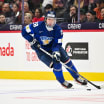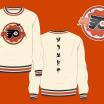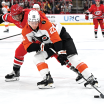On August 22, Flyers general manager and president of hockey operations Chuck Fletcher announced that the organization avoided arbitration with 25-year-old defenseman Travis Sanheim. The team signed the player to a two-year contract that carries a $4.675 million average annual value (AAV). The new contract represents a significant raise on the $3.25 million AAV that Sanheim received on the now-expired two-year "bridge" deal he signed in 2019.
Sanheim: "Now it's up to us."
Philadelphia avoided arbitration with 25-year-old Travis Sanheim, agreeing to two-year contract with the defenseman that carries a $4.675 million AAV

By
Bill Meltzer
philadelphiaflyers.com
During the negotiation process, the two sides discussed potential contracts of varying lengths. Inevitably, contracts that preempt future unrestricted free agent (UFA) status carry higher cap hits than shorter-term deals. Sanheim can become an unrestricted free agent in the summer of 2023. Had the Flyers and Sanheim's agent been unable to reach an agreement before an arbitration hearing, the player would have received either a one-year or two-year award from the arbitrator.
"This go-around, I think, was a little bit different. With the arbitration, I think, it kind of set a deadline when we were negotiating. We discussed all options. Ultimately, with the situation that we were in with the cap, I think it just made more sense to do something short term," Sanheim said.
Drafted by the Flyers with the 14th overall pick of the first round in the 2014 NHL Entry Draft in Philadelphia, Sanheim is now entering his sixth pro season and fifth in the NHL. He played one full year in the American Hockey League (2016-17) and made his Flyers debut the following year. His role and ice time have expanded since 2018-19. Sanheim averaged a career-high 21:53 of ice time in 2020-21.
In terms of total NHL games played, Sanheim (255 regular season games, 20 playoff games) is sixth among the team's defensemen. New acquisitions Keith Yandle (1,032 regular season games, 58 playoff games), Ryan Ellis (562 regular season games, 74 playoff games) and Rasmus Ristolainen (542 regular season games, zero playoff matches) are all older than Sanheim. Likewise, holdover veteran defenseman Justin Braun has played in 722 NHL regular season games and 100 playoff games in his career including 115 regular season games and 16 postseason matches with the Flyers.
In terms of seniority on the Flyers, however, only Ivan Provorov has been with the NHL team longer than Saheim among Flyers' defensemen. Provorov was drafted one year later than Sanheim but debuted in Philadelphia during the 2016-17 season. Owing to the fact that Sanheim is now a young veteran who has experienced firsthand all the highs and lows of the 2017-18 to 2020-21 seasons, one of his goals is assume more of a leadership role as the organization brings along the likes of prospects Cam York and Egor Zamula.
"I think you're starting to establish yourself more," Sanheim said. "You're starting to feel like you're grabbing a bigger piece of the pie. For me, leadership is a part of that and being able to show that with my experience and what I've kind of been through along the way that I can step up and start to provide that role."
The Flyers' opening night defense pairings will take shape over the course of training camp. As of now, the on-paper projection is for Provorov to play alongside Ellis, Sanheim to be paired with Ristolainen, and Yandle to play with Braun.
For his part, Sanheim is hoping for as much stability and continuity as possible. Sanheim partnered with Phil Myers (now a member of the Nashville Predators) for both the Lehigh Valley Phantoms and the Flyers, with mixed results. They clicked at times, and struggled at other times. Last season, in addition to playing with Myers. Sanheim played portions of the season with Braun and briefly alongside Provorov (his regular partner in the second half of the 2018-19 season). Sanheim has experience playing both left defense and the right side but would prefer to remain in one spot. He's played significantly more left defense than his off-side in the last two years but moved to right defense last season when he was briefly reunited with Provorov.
WIth the Flyers now once again (as they did in 2019-20) three right-handed and three left-handed defensemen within their projected top six, there will be an opportunity for everyone to play their natural side. The built-in disadvantage to playing the off-side on defense is that it forces the defenseman to play the puck on his backhand along the near-side boards and also means exposing the puck over the middle of the ice when carrying it. It's a makeable adjustment for many defensemen, including Sanheim. but it's often preferable to play one's natural side if possible.
"I think that was something that they looked at and wanted to address. It's difficult playing different partners, different positions, whether it's left or right. I think to be able to kind of settle in, find somebody, find some chemistry and somebody is going to make each other better and make our team better," Sanhein said.
More important than handedness alone is the blend of skill sets and styles on each defense pair. Sanheim likes to join the attack up ice, and does much of his best work when his team has possession of the puck. Although tall, he is not very physical. The right-handed Ristolainen, meanwhile, has often struggled in the puck possession aspect of the game but brings an aggressive physicality. Sanheim believes that, if the two are paired together, they could supplement each other's strengths -- both are very good skaters, and both have some point-production capabilities -- and offset areas where one is more accomplished than the other. If Sanheim does not play with Ristolainen, he might see time alongside Ellis; an undersized but complete player.
"I haven't spoken with [Ristolainen] yet personally, but I've heard some great things. Spoken to Mike Yeo about [Ristolainen and Ellis] and Chuck about them as well. I'm excited to get to know them, potentially play with them. I know our forwards have hated to play against them and go up against them every night, so if he can bring that to our side and it can be a great pair," Sanheim said.
Sanheim had an overall strong 2019-20 regular season and uneven 2020 Stanley Cup playoff (strong in the round robin and portions of the Montreal series, struggled against the New York Islanders). During the 2020-21 season, Sanheim had a roller coaster campaign. The positive was that he actually did fine from an analytics standpoint: 54.1 percent Corsi, 51.5 percent Fenwick Close, positive differential in expected goals despite a minus-22 traditional plus-minus rating. He was particularly effective in joining the play up-ice and prolonging puck possession for Philadelphia.
The negative: Sanheim struggled mightily at times during the season especially during the team's fateful swoon in March. He had issues with gap management, net-front containment, turnovers under forechecking pressure and unforced turnovers (40 charged giveaways). He took on a penalty killing role in 2019-20 for the first time in his career and showed promise, but was not as effective this past year amid teamwide PK struggles.
From an offensive standpoint, Sanheim was a top point producer by defenseman standards in the Western Hockey League and a well-above average one in the American Hockey League. In the NHL, he's periodically played on the second power play unit but did not regularly do so in 2020-21. In the past, he's flirted with double-digit goals a couple times but has yet to hit that mark. He posted 35 points in 2018-19; his career best to date.
Presently, although they were only briefly paired together this past season (they were a regular second-half pairing in 2018-19), Sanheim is the Flyers de facto No. 2 defenseman behind only Provorov. Although half of the blueline corps has been made over and two minutes-eating righthanded defensemen have been added in Ellis and Ristolaine, Sanheim will still be relied upon heavily next season. He is likely to once again average 20-plus minutes of ice time.
"A lot of changes. A lot of new faces. I think everyone's excited. I think we see a lot of good things in the moves that were made and gets us excited to get back to Philly. I know speaking with the other guys and the potential that we see. Chuck's done his job. Now it's up to us to come together as a group and show him the moves that he made and why he did them," Sanheim said.


















